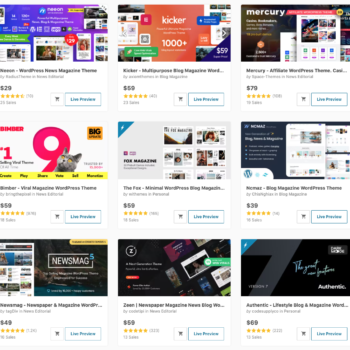You’ve poured your heart into creating amazing blog posts – filled with helpful tips, engaging stories, or insights that you just know could help others. But then… crickets. Getting those awesome posts in front of actual readers can feel like the biggest hurdle of all, especially as a beginner blogger.
Don’t worry, you’re not alone! Many new bloggers make the mistake of thinking, “If I build it, they will come.” But in the crowded online world, even the best content needs a little boost to get discovered.
The good news? Promoting your blog doesn’t have to be complicated or suck up all your time. There are plenty of easy, traffic-boosting strategies even beginner bloggers can use to get more eyes on their content – even with a small (or non-existent!) audience.
Ready to ditch the frustration and start seeing your readership grow? Let’s dive into some simple but powerful strategies you can implement right away.
1. Optimize for Social Media
Social media platforms offer a massive potential audience, but to truly connect, you need to go beyond just sharing links. Here’s how to make your blog content irresistible to share:
- Visuals are Everything: In a sea of text updates, make your posts stand out. Design eye-catching graphics using tools like Canva. Include your blog title, compelling images that relate to your topic, and even powerful pull-quotes from your post to pique curiosity.
- Tailor Your Message: Don’t be a one-trick pony! Instead of posting the same update across every platform, write short, punchy snippets customized for each network. Is your LinkedIn audience more likely to respond to a professional question? Does your Instagram following love behind-the-scenes glimpses? Play to each platform’s strengths.
- Harness Hashtags: Research a small set of highly relevant hashtags to expand your post’s reach. Tools like Hashtagify can help! But remember, quality over quantity – 3-5 targeted hashtags are far more effective than spamming a generic list.
- Timing is Key: When your target audience is most likely to scroll is when you want your posts to be seen. Each platform has analytics (even simple ones!), or experiment by posting at different times to discover your sweet spots.
- Get Smart with Scheduling: Batching your social media content creation is a lifesaver. Take an hour and schedule out several posts using tools like Buffer or Hootsuite (which often have free plans with generous options). This frees you up for real-time engagement, which is also crucial!
Pro-Tip: Don’t just share your own blog content! Curating interesting articles by others in your niche builds your credibility as a resource and often encourages those creators to reciprocate and share your work as well.
2. Leverage the Power of Email
In the ever-changing world of social media, email might feel old-fashioned, but it’s a remarkably effective tool for building a loyal blog following. Here’s why email marketing matters for bloggers:
- You Own the Connection: Social media algorithms can change on a whim, and your reach can plummet overnight. With your email list, you have direct access to readers who’ve actively chosen to hear from you. This control is invaluable!
- Nurture Relationships: Email is a fantastic way to deepen the reader-blogger connection. Share:
- Exclusive Content: Bonus tips, downloadable resources, or expanded insights that complement a blog post.
- Behind-the-Scenes Updates: Share your blogging journey, challenges, and wins to make it more personal.
- Ask for Feedback: Invite readers to reply to your emails, fostering two-way communication.
- Start Early, Start Small: Don’t be intimidated by the idea of huge email lists. Here’s how to get started:
- Simple Signup: Make it super easy to subscribe with a prominently placed signup form on your blog.
- Compelling Incentive: Offer something valuable in exchange for signing up:
- A “welcome” email series with your best tips
- A printable cheatsheet or checklist
- A short, actionable mini-course tailored to your niche
- Focus on Quality: A handful of highly engaged subscribers who open your emails is more powerful than a massive list of people who ignore you.
Pro-Tip: Choose an email marketing service provider (many offer free beginner plans) to help with signup forms, automated sequences, and basic analytics.
Example: DIY Blogger Offering a Free Resource
- Target Audience: People wanting to start a home improvement blog
- Freebie Offer: A PDF guide: “5 Tools Every DIY Blogger Needs (And How to Use Them on a Budget)”
- Email Content: Regular new post updates + exclusive discounts on featured tools, occasional surveys to get audience input for future content.
3. Engage in Relevant Communities: Build Trust, Then Share
Online communities are fantastic places to connect with your ideal readers, but success depends on genuine engagement. Here’s how to find the right ones and establish yourself as a valuable contributor:
- Niche Forums: The Goldmine
- Search Smart: Use keywords related to your blog topic + “forum” to find relevant communities.
- Lurk First: Before jumping in, observe the tone, rules, and types of discussions that flourish.
- Offer Value First: Answer questions, participate in existing threads, and become known as a helpful resource.
- Strategic Sharing: Only when it’s genuinely relevant to a conversation, can you say something like, “I wrote a blog post that expands on this topic, here’s the link if you’re interested.”
- Facebook Groups: Rules Matter
- Seek Out Your Tribe: Use Facebook’s search bar with niche keywords + “group.”
- Careful Observation: Thoroughly check the group rules on promotion – some disallow it entirely, others have specific days or threads for sharing.
- Focus on Community: Even in groups allowing promotion, lead with building relationships. Become a familiar face who’s known for helpfulness, not just dropping links.
- Reddit: The Trickiest Terrain
- Subreddit Research is Key: r/findasubreddit is helpful! Find those hyper-aligned with your niche.
- Reputation is Everything: Redditors are notoriously averse to self-promotion. Become a genuine contributor in related subreddits before ever considering sharing your blog.
- When in Doubt, Ask: Some subreddits have threads specific to seeking feedback or sharing work. If unsure, message the mods politely to ask about their policies.
Key Point: In ALL communities, think long-term relationships over quick hits. People can spot self-serving behavior a mile away. Genuine contributions are what ultimately build the ‘know, like, and trust’ factor that makes people interested in your blog.
Extra Tips
- Smaller is Often Better: Highly-focused communities, even with less members, can be more valuable than massive groups with less specific interests.
- Bookmark & Track: Keep a list of the communities you join, their rules, and where you’ve built up a bit of rapport.
4. Participate in Blog Commenting: The Art of Connection & Strategic Visibility
Find the Right Blogs:
- Niche Specificity: Drill down within your broad niche. If you blog about fitness, don’t just target any fitness blog. Focus on weightlifting, running, or home workouts – the more specific, the more likely your comments will actually resonate.
- Quality over Quantity: A few comments on high-authority blogs in your niche are worth more than dozens on irrelevant, low-traffic sites.
- Signs of Engagement: Do posts regularly receive multiple comments? Are there lively discussions happening, with the blog author responding? This shows an active community worth joining.
Comment Thoughtfully:
- Read the Post (Fully!): Skipping to the comments section defeats the purpose. Absorb the content, then offer something that expands on the topic at hand.
- Types of Valuable Comments:
- Share a Relevant Experience: Did you try implementing the post’s advice? Share your result, it gives the author social proof and enriches the discussion
- Offer a Different Angle: Respectfully disagree, but back up your viewpoint to spark debate (this gets attention!)
- Ask Probing Questions: Show you’re truly interested in going deeper on the topic, and invite others (and the author) to weigh in.
Subtle Promotion:
- Value First, Link Second: If you’ve established yourself as a thoughtful commenter, most blogs allow a link within your signature. This is where you drop your highly relevant blog post.
- Example: Let’s say you commented on a post about “Time-Saving Tips for Bloggers.” A natural signature link could be a post you wrote about “My 5 Favorite Tools to Streamline Blog Writing.”
- Don’t Force It: If no article you’ve written fits seamlessly, skip the link this time. Focus on building a reputation first.
Important Note: Many blogs use “nofollow” links on comments, meaning they don’t directly help your SEO, but they build brand awareness and can drive referral traffic from engaged readers!
5. Guest Post on Other Blogs
Guest posting offers a multi-pronged win for new bloggers: you gain exposure to a fresh audience, build backlinks for SEO, and establish yourself as a voice in your niche. Here’s how to make it a success:
- Strategic Targeting: Find blogs with a similar audience to yours, but slightly larger.
- Why It Matters: You reach people already interested in your topic, without competing with massively established blogs.
- How to Find Them:
- Track your competitors – Who links to them?
- Use the tool SimilarWeb to identify sites that overlap with your audience.
- Search footprints: Try searches like “[your niche] + guest post guidelines”
- Pitch with Value: Don’t just ask for a guest post spot. Offer 2-3 unique article ideas customized to their blog’s style and audience.
- Do Your Research: Thoroughly analyze their existing content (recent and popular posts) to understand their tone, what topics they cover, and any potential content gaps you could fill.
- Idea Examples:
- A unique angle on a topic they’ve covered, offering a differing perspective
- A step-by-step tutorial that aligns perfectly with their audience’s needs
- A roundup of resources, curated with their specific readers in mind.
- Bio Backlink: Include a short author bio with a natural link back to your own blog. This builds authority and drives relevant traffic.
- Keep it concise: 2-3 sentences max. Focus on your area of expertise and what you offer readers on your blog, rather than a laundry list of accomplishments.
- Anchor Text: Don’t just link your name. If possible, negotiate a keyword-rich anchor text (“Learn more on my personal finance blog [link]”)
- Be a Stellar Guest: Submit polished content that aligns with their guidelines. This increases the likelihood of future collaboration!
Additional Tips
- Quality over Quantity: A few well-executed guest posts on targeted blogs beat a dozen generic ones on irrelevant sites.
- Track Your Results: Monitor traffic referrals from guest posts to gauge which collaborations bring the most valuable readers.
Example: A food blogger might…
- Find Target Blogs: Those with readers interested in healthy recipes, but at a slightly larger scale than their own beginner-focused content.
- Pitch Ideas: “5 Easy Weeknight Dinners Under 30 Minutes”, “Budget-Friendly Meal Planning Tips for Busy Families”, or “Gluten-Free Baking Substitutions: Your Essential Guide”
- Bio Backlink: “Sarah is a mom and food blogger on a mission to make healthy eating simple. Visit her blog, [Blog Name], for family-friendly recipes and meal prep hacks.”
6. The Power of Repurposing: Content That Works Harder, Not Just Longer
One of the smartest things you can do as a blogger, especially a beginner, is to get maximum mileage out of each piece of quality content you create. Repurposing lets you do just that. Here’s why it’s a game-changer:
- Get More Mileage: Let’s say you write an in-depth blog post on “10 Essential Tools for Beginner Food Bloggers.” Instead of publishing it once and hoping for the best, repurposing turns that single piece into:
- Twitter Thread: Break down the 10 tools, offering one tip per tweet.
- Instagram Carousel: Design visually appealing slides with a key feature of each tool.
- Infographic: A visual breakdown of tools, perfect for sharing on Pinterest.
- Short YouTube Video: Demo 2-3 of the top tools with a link to the full post for more.
- Reach New People: Not everyone consumes content the same way. Some love long-form articles, others prefer quick tips on Twitter, and still others are drawn to visuals. Repurposing meets people where they are.
- Time Saver: The core research and idea are done! Here’s how to streamline the process:
- Plan While You Write: Jot down ideas for repurposed content as you create your original blog post.
- Batch Your Work: Set aside an hour to create all the repurposed formats in one go. This is more efficient than doing bits and pieces scattered throughout the week.
- Tools Help: Canva for graphics, simple video editors – even free options can be powerful!
Example: From Blog Post to Podcast
Don’t limit yourself to text and visuals. If your blog post is a “How-to” or offers advice, a few tweaks could turn it into a podcast episode!
- Script It Out: Use your post as a base, but make it more conversational.
- Record: Even a smartphone mic is fine to start. Focus on clear audio over fancy gear.
- Simple Edit: Cut out any stumbles, add intro/outro music (tons of royalty-free options!).
- Share: Embed on your blog, upload to basic hosting (Anchor.fm is free), or submit to major podcast platforms!
Pro-Tip: Link between all your repurposed content! Include a mention of the original blog post in your video description, pin the tweet thread to your profile, etc. This creates a web leading people back to your main hub – your blog!
7. Harness Visual Platforms
Visual platforms like Pinterest and Instagram have immense potential for bloggers, but success lies in strategic execution. Here’s how to maximize your visual promotion efforts:
Pinterest Power
- Design Matters: Use Canva or similar tools to create visually appealing templates for your blog post pins. Bold fonts, high-quality images, and a clear blog title are essential.
- Multiple Pins: Create several pins per post, each with a slightly different design, text overlay, or focus. This lets you test what your audience responds to best.
- Keywords Everywhere: Pin titles, descriptions, and board names should all be optimized with relevant keywords. Think like a Pinterest user searching for your content.
- It’s a Search Engine: Pinterest prioritizes fresh, relevant content. Consistently pinning (even older content!) demonstrates your blog’s activity and value.
Instagram Savvy
- Not Just Pretty Pictures: While visually appealing content matters, focus on providing value as well. Variety is key for keeping your audience engaged.
- Mix it Up:
- Behind-the-scenes peeks into your blogging process
- Pull-quotes from posts transformed into graphics
- Polls or questions to spark discussion
- Re-share posts from other relevant accounts (with credit!) showing you’re part of a community
- Call to Action: Don’t just say “link in bio”. Tell people why they should click: “Learn how to do X”, “Get your freebie today”, etc.
- Bio Link Tools: Use tools like LinkTree to house multiple links in your Instagram bio, as you can only have one clickable link.
Hashtag Strategy (Applies to Both)
- Research Tools: Sites like All Hashtag and Tailwind help you find relevant hashtags with data on their popularity and effectiveness.
- Mix and Match: Use a blend of:
- Broad niche hashtags (ex: #bloggingtips)
- Super specific ones (ex: #foodblogpromotion)
- Location-based (if relevant to your content)
- Branded hashtags (unique to your blog/brand)
- Track and Adapt: Check your social media analytics or insights. See which hashtags get your posts more engagement, and ditch those that get no traction.
Pro Tip A smaller number of laser-focused hashtags is better than 30 generic ones!
8. Collaborate with Other Bloggers
Building connections with other bloggers in your niche is one of the best ways to expand your reach and boost credibility. But not all collaborations are created equal. Here’s how to find the perfect partners:
- Mutually Beneficial: The Key to Success
- Cross-Promotion: Share each other’s content on your respective social channels, offering authentic recommendations to your followers.
- Guest Post Swaps: Write original blog posts for each other’s sites, getting exposure to a whole new audience while providing fresh content for your own readers.
- Round-Up Posts: Partner with several bloggers to create posts like “10 Best Beginner Blogging Tips” where each person contributes a section. These often get shared widely across all contributors’ networks.
- Finding Your “Perfect Match”
- Similar Reach: When starting out, look for bloggers with similar audience sizes. This ensures the collaboration is equally valuable for both of you.
- Complementary Niches: You want enough overlap in your target audience for it to make sense, but not be direct competitors. (Ex: a food blogger + a travel blogger focusing on foodie destinations)
- Quality Matters: Collaborate with bloggers whose content you genuinely admire and believe would resonate with your readers.
- How to Find Collaboration Partners
- Social Media: Follow relevant hashtags, join niche-specific Facebook groups, and actively participate in discussions.
- “Contact Me” Pages: Many bloggers are open to collaborations – if you love their work, reach out!
- Networking Events: Blogging conferences or even local meet-ups in your niche can foster amazing partnerships.
Pro-Tip: Start by building genuine relationships. Comment on their posts, share their content, and be a supportive member of the community before asking for a collaboration. This makes your pitch far more likely to succeed.
9. Don’t Underestimate “Old School” Tactics
Sometimes the tried-and-true methods still pack a punch! While your primary focus will likely be online promotion, offline tactics can subtly support your efforts, especially if your blog’s niche has a local/personal element.
- Business Cards:
- Target Wisely: If your blog caters to local businesses, is craft-related (and you sell your wares), or you offer freelance services, then absolutely include your blog URL.
- Subtle Design: Don’t make your blog the focal point of the card. Include it in a small, tasteful font along with your other contact info.
- Conversation Opener: Handing out your card after a helpful conversation where your blog-relevant knowledge came up is the perfect way to make it feel like a natural follow-up resource.
- Email Signatures:
- Keep it Simple: “Check out my blog on [topic] – www.yourblog.com [invalid URL removed]”
- Professional Touch: For work-related email signatures, ensure your company is okay with this, and that your blog’s content aligns with a professional image.
- Beyond Direct Promotion: If your blog offers free resources, you can position it helpfully: “Need more [niche] tips? Check out my free guides on my blog!”
- Word of Mouth:
- Organic is Best: Forced mentions feel awkward. Let conversations about your interests come up naturally.
- Example: Lifestyle Blogger: Someone mentions struggling to find healthy meal ideas.” You know, I’ve been experimenting with that lately and sharing recipes on my blog, I could send you the link if you’re interested!”
- Enthusiasm over Selling: If people sense genuine passion, they’re more likely to check your blog out. Hard-selling puts people off.
Important Caveat: These tactics are best as supplements to your online promotion. Don’t rely on them as your primary strategy, especially if your niche doesn’t naturally lend itself to in-person interactions.
10. Consistency is Key
The old adage “slow and steady wins the race” rings especially true when it comes to blog promotion. Overnight success is rare. It’s the consistent, focused effort over time that builds momentum and attracts a loyal readership.
- Realistic Approach: Pick 2-3 strategies that excite you, and focus on those deeply rather than trying everything half-heartedly. Don’t feel pressured by what everyone else is doing. Find strategies that feel enjoyable or you’re naturally curious about – you’re far more likely to stick with them.
- Small Wins Add Up: Set aside even 15 minutes a day for promotion. Consistency over huge bursts of sporadic activity is what gets long-term results. Block out a specific time for promotion, whether it’s during your morning coffee or right after you publish a post. Make it a non-negotiable part of your blogging routine.
Why Consistency Matters
- Algorithms Reward It: Social media platforms and search engines favor accounts that post regularly. This doesn’t mean every day, but a predictable cadence signals you’re a reliable source of content.
- Audience Building: People crave what’s familiar. If they know you offer fresh insights every Tuesday, or a Twitter thread of tips every weekend, they’re more likely to keep coming back.
- Habit Formation: For YOU, the blogger, consistency makes promotion less daunting. It becomes an integrated part of the blogging process, not a stressful afterthought.
- Compounding Results It may seem slow initially, but each share, each interaction chips away. Over time, those consistent efforts lead to noticeable growth and increased visibility
Remember, building a loyal readership takes time. Be patient, celebrate small wins, and keep putting out high-quality content alongside your promotional efforts. Over time, you’ll see your traffic and engagement steadily climb!
Conclusion: Blog Promotion Made Simple (and Successful!)
See? Promoting your blog doesn’t have to mean endless hours on social media or complex strategies best left to marketing gurus. By focusing on a few easy-to-implement tactics, you can start attracting more readers and get the recognition your awesome content deserves.
Remember, the best approach is to start small. Pick one or two strategies from this list that seem like a good fit for your niche and your available time. Focus on doing those consistently, and watch your audience grow over time.
Blog promotion, like blogging itself, is a marathon, not a sprint. Consistent effort pays off. Don’t get discouraged if you don’t see overnight viral success – keep creating valuable content, keep implementing these strategies, and the readers will come.
Call to Action
Ready to take the first step? Share in the comments below which strategy you’re going to try first! Whether it’s crafting eye-catching social graphics, joining a niche community, or finally starting that email list, I’m cheering for you!









No Comments
Leave a comment Cancel